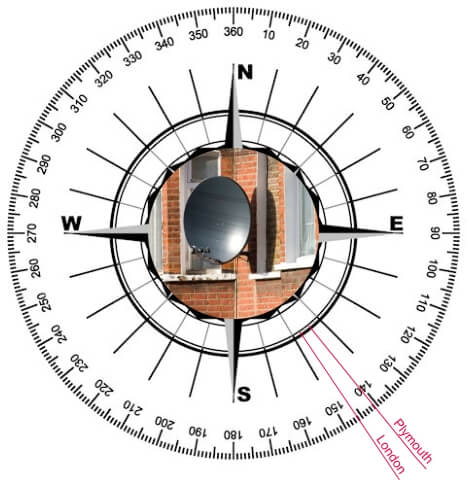
Navigating using natural signs around you.
by Survival Expert James Mandeville ©2020
This article is primarily for:
The Military, Outdoor Enthusiasts and General Interest.
- RETURN TO ARTICLES LIST -
Using the signs around you.
Trees and plants can help in navigation but there are many factors to be taken into account and trees and plants should only be used as a rough guide for determining direction when other, more reliable methods, cannot be used.
Determining direction using the effect of the prevailing wind.
Trees can act as a rough guide to determine the direction of the prevailing wind. For this method of navigation, one must first know the direction of the prevailing wind in the country you are in. The prevailing wind in the UK, for example, comes from the south–west. Extremities of exposed trees on hilltops may look shaped by the wind blowing from the south–west to the north–east, so trees will have a lower profile facing the south–west and a higher profile at the north-east.
Fir trees are not a good guide as to the direction of the prevailing wind, but single deciduous trees demonstrate this effect well. Trees growing in woodland shade each other and the effect is less obvious. Trees growing on the fringes of woodland are also less reliable pointers.
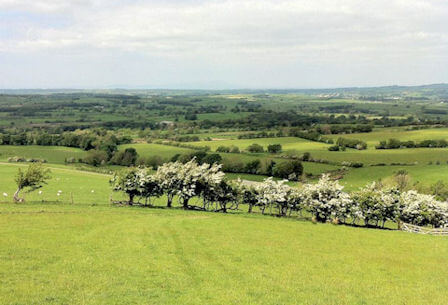
Hawthorn trees growing in the UK Lake District show the direction of the south–west prevailing wind.
Determining direction by studying strongest growth.
Study several trees and walk around them a couple of times to decide how a tree, or group of trees, is growing. In northern temperate climates, branches of single, exposed trees, tend to grow stronger, and foliage tends to be denser on the side of the tree facing south. In southern climates the reverse is generally true.
Branches growing on the southern side of a tree are more horizontal spreading out south towards the sun and tend to have more foliage. Branches on the northern side of a tree tend to grow more vertically upwards towards the sunlight and tend to have less foliage. When a tree is viewed from west to east this is more difficult to see, which is why it is necessary to walk around a tree to decide how the branches are growing.

Hawthorn tree growing in the UK Yorkshire Dales shows strong growth on the southern side with more horizontal growth. On the northern side the growth is more vertical
With a little practice the effect of the prevailing wind and areas of strongest growth can often be spotted in more sheltered areas, and occasionally even in towns.
Can you tell direction from moss?
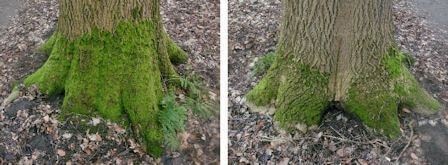
The moss on a tree trunk is often an indicator of direction but is not 100 per cent reliable so examine several trees to see if the following holds true in the area you are in. In the northern hemisphere, the northern side of the trunk (photo left) catches less sun, is damper and more moss grows on this side. The southern side of the same trunk (photo right) is sunnier, drier and has less moss growing on it. If the tree has leaves, you should be able to see that the south facing side of the tree has larger leaves and stronger growing, more horizontal branches.
Because moss grows where it is wettest it is not a very reliable indicator. For example, a tree with thick bark that holds more moisture can encourage moss to grow and this may not be on the side of the tree facing due–north, so take care when using this pointer.
Determining direction using plants in general
Many plants follow the track of the sun, for example, sunflowers. Other plants align their leaves vertically and point in a north-south direction on sunny days in an attempt to keep cool in the midday sun.
Taking the average alignment of several of these plants and their leaves growing in an open position will enable a good rough estimate of north and south.
Lichen
While most lichens are grey/green and grow in shaded areas, Xanthoria Parientina is a more vivid rust colour and it only grows on south–facing surfaces such as, stone walls, fencing, etc.
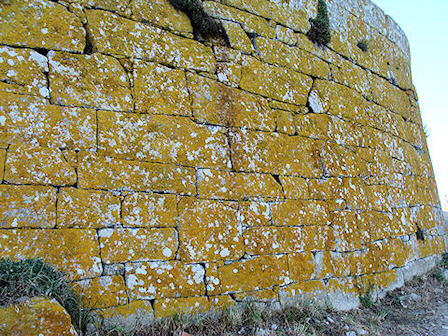
Xanthoria Parientina.
Finding directions using an ant–hill
More than 10,000 known ant species occur around the world. They are especially prevalent in tropical forests, where they may be up to half of all the insects living in some locations. It is often cited that the shape and direction of ant nests can be used to determine south. This is not true of all species and is only a very rough navigational guide.
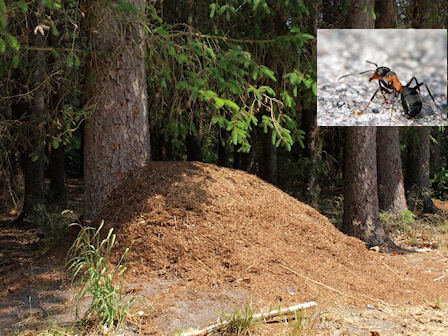
Ant–hill of the species Formica rufa, UK, showing south–facing entrance
Ants are common in the UK. Formica rufa, the red wood ant found in the pine forests of southern England, builds large thatched mounds which, like another common ant, Lasius fuliginosus, tend to start centred around old tree stumps. Nests tend to be situated on the edge of pine forests, particularly where a pathway meets the forest edge; this is because the ants like to have the sun shine on the mound as much as possible in order to keep it warm.
Formica rufa build their mounds with the south facing slope being at a gentler incline than the other sides. They do this so that the south–facing slope, which is the side facing the sun most of the day, has a larger surface area and therefore captures more of the sun's warmth.
There are several varieties of wood ant in the UK. All choose a south–facing site to make the most of the warmth. Only the Scottish wood ant is tolerant of denser, shadier woodland and this makes them less reliable indicators of south.
To find approximate south, stand with your back to the nest as if you have just walked down the shallow slope it represents and you will be facing in a southerly direction. Check out other nests to make sure this is constant and look out for other natural signs to make sure you have a good approximation of south based on more than one natural indicator.
Be aware that not all ant–hills in the UK face south! The yellow meadow ant (Lasius flavus) occurs throughout Europe and Britain (and is also found in Japan). The mounds usually have one flat face which is oriented towards the south–east, thus maximising the benefits of the early morning sunshine.
When in North America
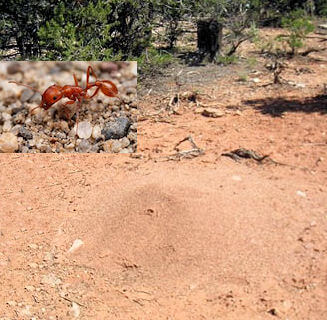
Ant–hill of the species Pogonomyrmex occidentalis, USA
(Showing south–eastern–facing entrance)
(Showing south–eastern–facing entrance)
In the western part of the United States the harvester ant (Pogonomyrmex occidentalis), the mound builder ant, only makes entrances to the mound on the bottom of the south–eastern side. The nest of the silver ant (Formica argentata) is oriented the same way in mountain areas of the State of Colorado. Some ants in the southern states build ant–hills on slopes facing south–east to maximize the ant–hill's exposure to the rising sun in the autumn (fall) and in the winter. Mounds are built near trees or rocks on the south or south–east side.
When in Australia

Magnetic termite mounds, Australia, with a north-south orientation
The ant fauna of Australia is especially large and diverse. World–wide, there are 16 subfamilies, about 300 genera and about 15,000 described species and subspecies of ants. Australia is currently known to have representatives of 10 subfamilies, 101 genera and 1275 described species and subspecies. In Australia's Northern Territory, inside the protected Litchfield National Park, near the township of Batchelor, about 100 kilometres south–west of Darwin, termites build peculiar mounds that are mysteriously aligned to the earth's magnetic field. Wide swathe of empty ground are filled with hundreds of termite mounds that look like tombstones from a distance, but much larger. The magnetic termite mounds rise to as much as three meters in height, look relatively flat and they all face the same direction with their thinner edges facing the south like the needle of a compass. As in the UK and the United States, ant–hills are normally constructed to catch the early morning sun with the entrance facing south or south–east.
In general
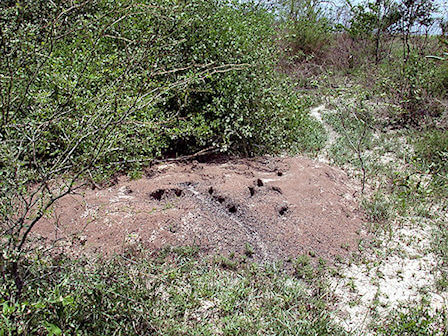
Ant–hill of Atta vollenweideri (leaf cutter) ants found in Argentina, Bolivia, Brazil, Paraguay, Uruguay. Entrance faces south–east but this may vary as vital ventilation means the entrance has to face the prevailing wind.
Most ant–hills and nests around the world are thermally regulated and most either face north to south with the entrance at the south or face north–west to south–east with the entrance at the south–east. They are only a rough guide to direction and you have to know which species of ant you are studying in order to decide on the direction of the entrance. This makes an ant–hill an unreliable indicator of direction to most people. If you have scientifically proven knowledge that can be used to expand our understanding of using ant–hills to determine direction in other parts of the world, please contact the author.
Using other signs
Finding one's direction without a map or compass is mostly a matter of being observant and using local and historical knowledge or knowledge of the landscape. For example, most older churches in the UK are constructed with the entrance facing approximately West and the altar facing approximately East. It's not an exact science but can be used with other observations to get a more accurate idea of one's true orientation.


Satellite dishes
All home satellite dishes point to the same geostationery satellite. For example in the UK, depending on where you are in the country they point between N141° to N146°. (Plymouth = N141°, London = N146°, Manchester = N144°, Glasgow = N143°, Aberdeen = N14°. In Holland, Amsterdam = N152°, Rotterdam = N150°. Most European countries fall in the range of bearings from N141° – N168°. You can look this up for your own country or those you are visiting and this can vary greatly, in Ohio, USA, for example, dishes point N225° (south–west).
